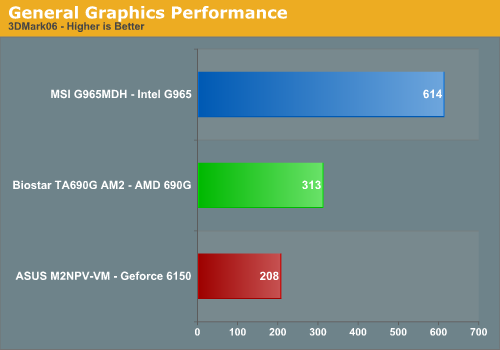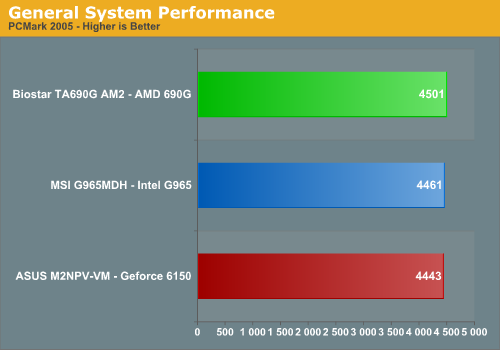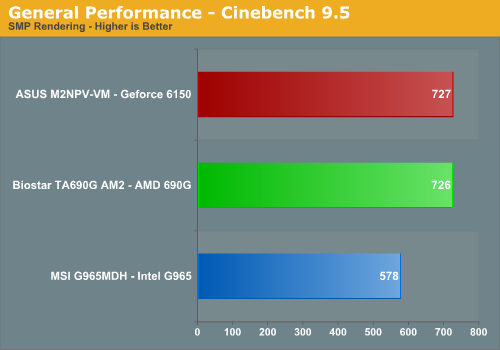Synthetic Graphics Performance
The 3DMark series of benchmarks developed and provided by Futuremark are among the most widely used tools for benchmark reporting and comparisons. Although the benchmarks are very useful for providing apple to apple comparisons across a broad array of GPU and CPU configurations they are not a substitute for actual application and gaming benchmarks. In this sense we consider the 3DMark benchmarks to be purely synthetic in nature but still valuable for providing consistent measurements of performance.

In our first test, the combination of the Intel Core 2 Duo and G965 makes for a great showing against the AM2 offerings. Okay, so we're being a bit sarcastic in that announcement as we consider these results to be anything but great. The Intel platform had no issues running the full 3DMark series but our AMD platforms could not complete the Shader Mark 3.0 tests. However, they exceeded the Intel platform scores in both the SM 2.0 and CPU tests. While the Intel platform passed the SM3.0 tests, this means little in actual game performance where the G965 failed to properly run games with SM3.0 capability.
General System Performance
The PCMark05 benchmark developed and provided by Futuremark was designed for determining overall system performance for the typical home computing user. This tool provides both system and component level benchmarking results utilizing subsets of real world applications or programs. This benchmark is useful for providing comparative results across a broad array of Graphics, CPU, Hard Disk, and Memory configurations along with multithreading results. In this sense we consider the PCMark benchmark to be both synthetic and real world in nature and it provides consistency in our benchmark results.

The margins are closer in the PCMark05 results with the 690G platform showing a minor advantage over the G965 and 6150 platforms. While this benchmark is designed around actual application usage, we will see if these results mirror our application testing.
Rendering Performance
We are using the Cinebench 9.5 benchmark as it tends to heavily stress the CPU subsystem while performing graphics modeling and rendering. Cinebench 9.5 features two different benchmarks with one test utilizing a single core and the second test showcasing the power of multiple cores in rendering the benchmark image. We utilize the standard multiple core benchmark demo and default settings.

The AM2 processors have always enjoyed an advantage in this test and the results continue to show the AM2 platform being dominant in this benchmark with a 26% advantage. The two AM2 platforms basically tie each other indicating CPU throughput is equal on either solution.
The 3DMark series of benchmarks developed and provided by Futuremark are among the most widely used tools for benchmark reporting and comparisons. Although the benchmarks are very useful for providing apple to apple comparisons across a broad array of GPU and CPU configurations they are not a substitute for actual application and gaming benchmarks. In this sense we consider the 3DMark benchmarks to be purely synthetic in nature but still valuable for providing consistent measurements of performance.

In our first test, the combination of the Intel Core 2 Duo and G965 makes for a great showing against the AM2 offerings. Okay, so we're being a bit sarcastic in that announcement as we consider these results to be anything but great. The Intel platform had no issues running the full 3DMark series but our AMD platforms could not complete the Shader Mark 3.0 tests. However, they exceeded the Intel platform scores in both the SM 2.0 and CPU tests. While the Intel platform passed the SM3.0 tests, this means little in actual game performance where the G965 failed to properly run games with SM3.0 capability.
General System Performance
The PCMark05 benchmark developed and provided by Futuremark was designed for determining overall system performance for the typical home computing user. This tool provides both system and component level benchmarking results utilizing subsets of real world applications or programs. This benchmark is useful for providing comparative results across a broad array of Graphics, CPU, Hard Disk, and Memory configurations along with multithreading results. In this sense we consider the PCMark benchmark to be both synthetic and real world in nature and it provides consistency in our benchmark results.

The margins are closer in the PCMark05 results with the 690G platform showing a minor advantage over the G965 and 6150 platforms. While this benchmark is designed around actual application usage, we will see if these results mirror our application testing.
Rendering Performance
We are using the Cinebench 9.5 benchmark as it tends to heavily stress the CPU subsystem while performing graphics modeling and rendering. Cinebench 9.5 features two different benchmarks with one test utilizing a single core and the second test showcasing the power of multiple cores in rendering the benchmark image. We utilize the standard multiple core benchmark demo and default settings.

The AM2 processors have always enjoyed an advantage in this test and the results continue to show the AM2 platform being dominant in this benchmark with a 26% advantage. The two AM2 platforms basically tie each other indicating CPU throughput is equal on either solution.










70 Comments
View All Comments
SignalPST - Tuesday, March 6, 2007 - link
I'm interested in this topic as well.Then again, I still waiting for them to come out with a HDMI sound card.
StriderGT - Wednesday, March 7, 2007 - link
Unfortunately there are lots of us who are still waiting for a true HDMI PC audio solution. You can check the thread I started with many technical details for that matter here: http://www.avsforum.com/avs-vb/showthread.php?t=79...">http://www.avsforum.com/avs-vb/showthread.php?t=79...Patrese - Tuesday, March 6, 2007 - link
Great review, thanks... I know I asked that a couple times already, but is there a mATX roundup planned here at AT? I'd like to see the Asus M2NPV-VM and Abit NF-M2 NView compared with its 690G counterparts, as this segment makes for most of the computer sales on most places? BTW, weren't you plaged by memory compatibility issues with the M2NPV-VM oe any of the boards tested? This Asus board showed extremely picky on my experience...Gary Key - Wednesday, March 7, 2007 - link
The roundup is scheduled on the 19th, trying to pull it in. What BIOS and memory are you using on the M2NPV-VM, so far I have not run into any real issues except with 2GB modules. The abit board is one of my favorites so far. ;)Patrese - Tuesday, March 6, 2007 - link
There shouldn't be a question mark at the end of the "most sales" phrase... There are also a couple typos, sorry about that. Where's the edit button anyway? ;)RamarC - Tuesday, March 6, 2007 - link
i don't really understand the point of comparing chipsets/motherboards between processor families. subsystem performance figures can show glaring deficiencies but otherwise it really boils down to a cpu comparison. the "media/audio encoding" and "media performance" sections are certainly cpu-centric. and pitting a $230 x2 5200+ against a $185 e6300 winds up handicapping the intel contestant. shouldn't the $222 e6400 have been used instead?Gary Key - Tuesday, March 6, 2007 - link
As stated in the article, AMD is marketing the AM2 and 690G/V as a platform design to compete against the G/Q965 and Core 2 Duo solution. The 690G is targeted to the multimedia, HTPC, home/office, casual gaming crowd and was tested as such. We looked at the total price of a base Core 2 Duo and decent G965 board and then matched the processor choice that would come closest to the price and performance of the Intel offering while meeting the platform cost. Our tests were chosen based upon the target audience for each platform in the home environment. This was not a review of office level machines as the Q965/963 and 690V are targeted to the business user.JarredWalton - Tuesday, March 6, 2007 - link
The conclusion mentions that the G965 + E6300 costs around $300 compared to $315 for the 690G + 5200+ (or 6150 + 5200+), so it's more or less a fair "equivalent price" platform comparison. The E6400 ends up being faster than the E6300, but still slower in a few tests (as the text mentions) and even faster in those tests where E6300 already holds the lead. Nothing new there - we've pretty much beat the "Core 2 Duo is faster" drum to death. We feel anyone looking at 690G is going to be interested in the platform as a whole much more than whether or not it is faster than equivalently price Core 2 offerings.mostlyprudent - Tuesday, March 6, 2007 - link
There may be too many variables, but perhaps you could come up with a way to normalize the benchmarks. For instance, run the gaming tests first with ultra high-end graphics to try and isolate the performance delta for each plattofrm/cpu combo you will test with. Then run the game benchmarks with the IGP solutions and adjust the scores based on the previous tests. Just a thought off the top of my head.asliarun - Tuesday, March 6, 2007 - link
Ah, but you're evaluating a chipset here, not a platform or a system solution. Having said that, I agree that it IS difficult to compare chipsets that are targeted for different CPUs. In such a case, a better way to evaluate might be to take an AMD and an Intel CPU that is similar in performance (not in price), and use them to compare their corresponding chipsets. That would highlight the differences between the chipsets. You could always mention the price alongside, or do a separate price/performance comparison alongside.My point is that a price/performance comparison should complement a pure performance comparison, not the other way around.